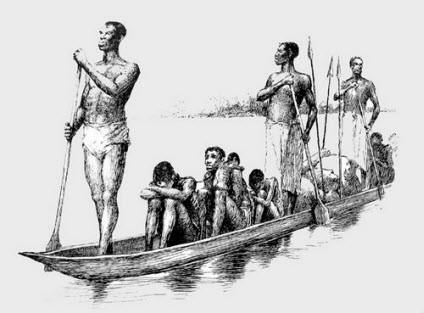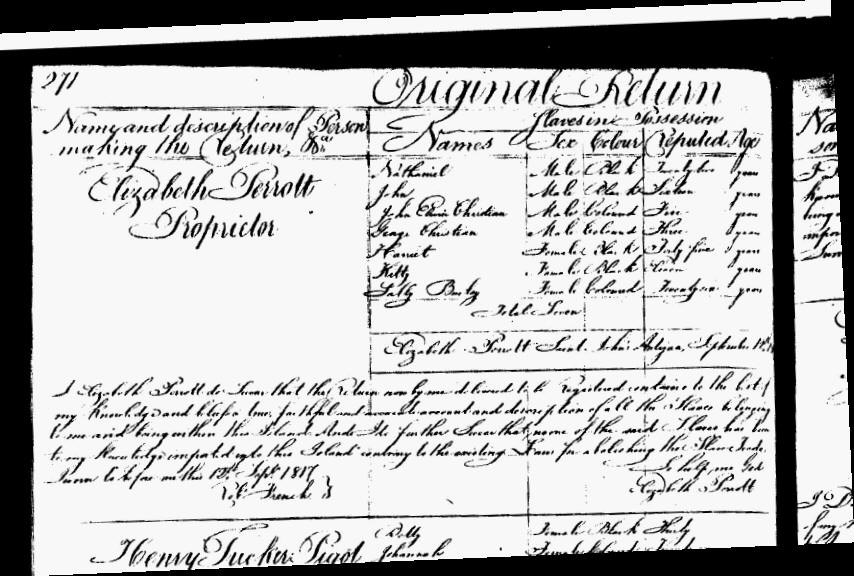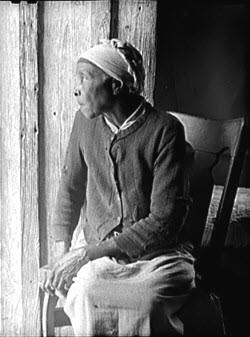It is understandable that many family historians, finding famous, distinguished or otherwise remarkable ancestors feel rather pleased with themselves and like to shine in what they see the as reflected glory of their ancestors.
Would they, however, be quite so happy if they found relatives who had engaged in or profited by the slave trade?

Before the slave trade was officially abolished in Britain in 1807 many people here grew rich on what was known as the ‘triangular trade’ – triangular because ships sailed from ports in the UK (Bristol was just such a port) to West Africa, carrying British goods which they traded for slaves collected by native slave traders. This old illustration depicts slaves, with their captors, being moved from their inland villages to the coast where they will be transported under dreadful conditions to the West Indies and the eastern states of America.
The slaves were transported to the Americas and the West Indies where the money raised by their sale was used to purchase local produce such as sugar, rum, cotton and tobacco.

From a commercial point of view it was astonishingly successful because a profit was made on each of the three legs of the voyage and it brought great wealth to Britain and other countries. To this day many a large country house in the UK and elsewhere, built with the profits of this reprehensible trade, still stands.
Slave registers for parts of the United States can be viewed on www.ancestry.com and members in that country should have a look at these records. However in the early days much of the British trade was with the West Indies and below you will find two extracts involving P*RR*TTs, one in Antigua and one in St. Christopher. There are doubtless many others to be found by keen researchers.

In case, like me, you find reading small print isn’t easy, this document dated September 1817 records the slaves owned by Elizabeth Perrott, their colour and reputed age: Nathaniel, black, 25; John, black, 16; John Edwin (?) Christian, coloured, 5; George Christian, coloured, 3; Harriet, black, 45; Kitty, black, 11; and Sally Bailey (?), coloured, 26. I take it that coloured means mixed black/white race.
This survey of slaves and their owners appears to have taken place every 3 years and later versions show that Elizabeth Perrott had died but her executors continued to run her estate and are referred to as such in the later surveys. The name Elizabeth of course was widely used, but do you recognise the name at that date and in that place?
Slave records also exist for the former British colony of Mauritius. Those who have been to this island in the Indian Ocean and seen the enormous crops of sugar cane growing there will appreciate why the landowners were so keen to obtain slave labour to keep their costs down and their profits up. There were numerous ‘employers’ with variants of the Perrott name but since Mauritius also has considerable French history most of them were probably of French descent. Nevertheless very large numbers of slaves were kept here and this almost certainly explains the racial and cultural mix which is such an attractive part of the island today.
Although the slave trade was abolished in the British Empire in 1807 the final stage in the process did not take place until 1834 when the slaves were emancipated, ie. freed. A memorial to this event was erected and is known as the Buxton Memorial Fountain, in Victoria Tower Gardens, Millbank, Westminster, London.
I know that some members have found in the course of their research that relatives lived for at least some of their lives in the West Indies. Some of them must have been engaged in the local agriculture business which suggests estates, sugar cane and slaves. If you have found proof of this, the editor would appreciate hearing from you.
The other part of the trade – the ship owners and mariners who operated the ‘triangular trade’ are harder to trace because useable censuses had not started when the trace was abolished. Bristol was of course not the only city made rich by the slave trade – Liverpool was one of several others. It would be interesting to know if members whose ancestors included mariners from any western or southern port in the UK have been able to find evidence that any of them worked on, or even owned, ships engaged in the trade. Understandably documentation from that time is hard to find – it seems likely that some was conveniently ‘lost’ at some time in the past, but are there any slave ship logs still held in any accessible archive?

My interest in the connection between the P*RR*TTs and the slavery trade was aroused when I came across this mystery photo. The lady (above) was named as Mrs Fanny Parrott. Where and when was this picture taken? Her surroundings look like a typical late 19th century cabin in the southern states of the USA, little better than the slave cabins of previous years. Her clothing suggests she worked on the land, possibly farming cotton or tobacco, the staple crops of the former slave states. But how did she get her name? Was she really married to someone of European ancestry named Parrott, or was the title ‘Mrs’ simply a polite way of addressing a middle aged woman? Can you identify her or her family for us?
